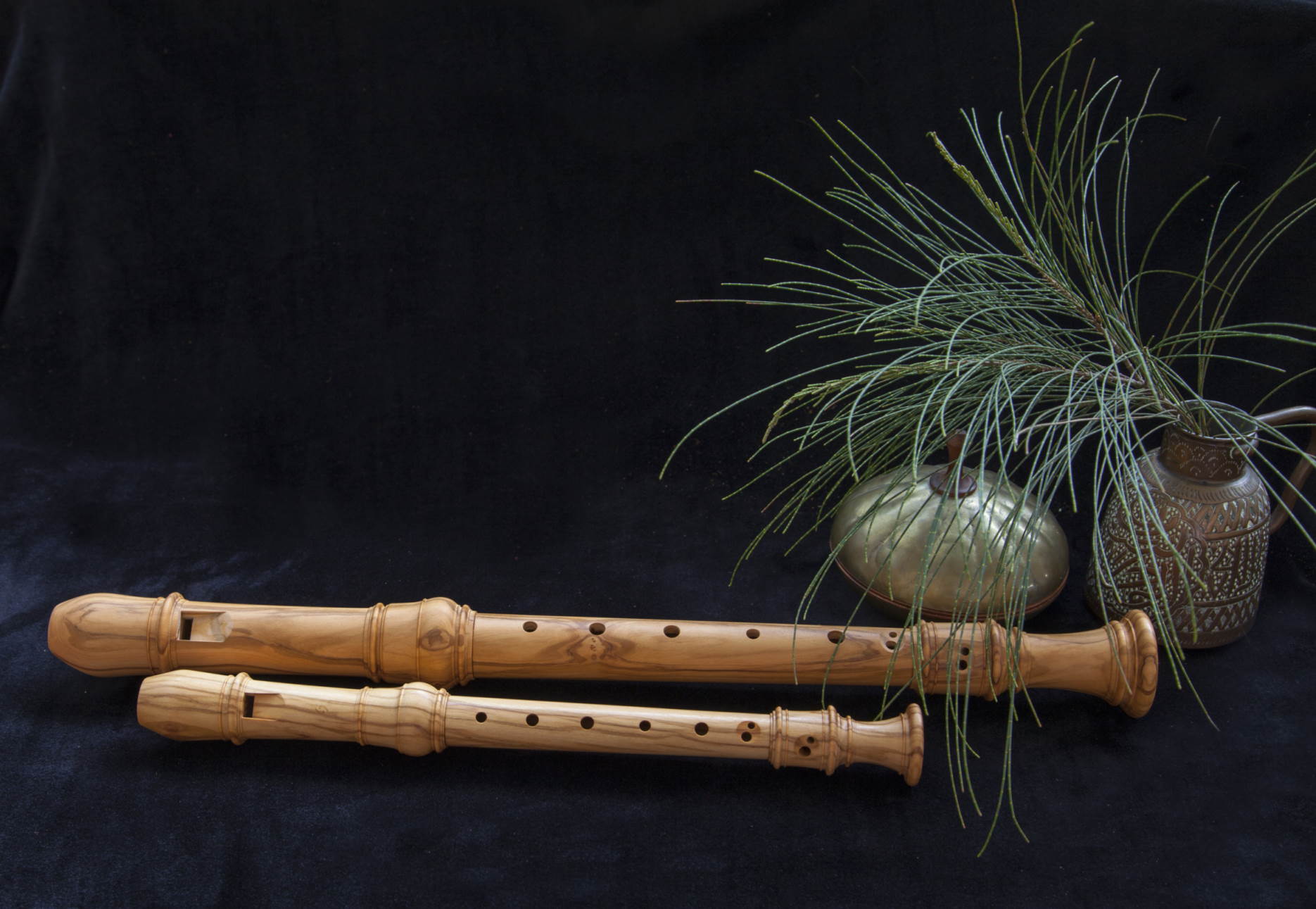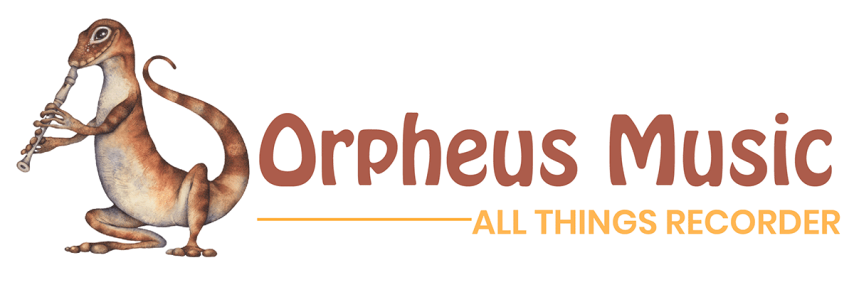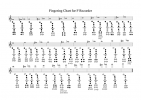
A guide to starting your recorder journey, which recorder to choose and why.
Should I play descant/soprano or treble/alto? C or F Fingering? and other FAQ
Not sure where to start? What's the difference between alto and soprano? Which instrument should I choose to learn? What type of recorder should I learn if I want to join a recorder society or ensemble?
This article is written for those just starting out in their recorder journeys. It will discuss things in general terms as everyone’s recorder experiences will differ, and should be used only as a guide. We also have a starting the recorder guide for books to start learning either descant or treble recorders.
Soprano/Descant C fingering
Descant recorders, also referred to as soprano recorders, are the most common type of recorder used in schools to teach music to children. However in the world of the recorder, it isn’t the main type of recorder used - the main recorder is the treble/alto recorder.
The descant/soprano uses C fingering, which basically refers to the lowest note being a ‘C’.
If you are an adult thinking about starting the recorder, it is recommended that you learn the treble/alto recorder. This is because:
The descant has a very high pitch, which means it can be quite piercing to the ear (especially if you’re just starting to learn the instrument).
Most of the Baroque repertoire was written for the treble which has a lower range and sounds in general nicer to the ear (just like the piccolo to the flute).
Most ensembles only need (or desire) one descant player, however they need a lot more treble, tenor and bass recorders. So you are more likely to be accepted into a group on the lower-pitched recorders. In general the music tends to be a bit easier on the lower parts, which is ideal if you are starting your musical journey. It can be awfully hard to start with the most ornamented/virtuosic part in an ensemble.
If you are an adult, your hand span will be able to stretch easily to a treble.
If you have wrist or finger injuries, or suffer from arthritis, there are recorders with keys and now there are tenors with knick necks to help you with any hand span problem nowadays.
If you would like your child to learn the recorder, then the choice depends on their age and hand span. If your child is very young or has a very small hand span then they should start learning on descant (or even a sopranino or garklein). However, if they are aged over 8, and if their hand span is large enough, you can start them on treble/alto.
Obviously, if you love the soprano recorder learn the soprano! Recorder players in general usually learn both instruments, and eventually learn all four recorders (SATB - soprano, alto, tenor and bass) if they really fall in love with the recorder. There’s no right or wrong in your choice, but starting with alto will make your recorder journey a little easier to start. You can also swap between tenor and soprano seamlessly as they both use the same C fingering making it easier to join a recorder ensemble or recorder society.
Treble/Alto F fingering
The treble or alto recorder is the most popular instrument of the recorder family, with most of the solo repertoire composed for its range. It is lower in pitch than the descant (and less likely to annoy your neighbours!).
The treble uses F fingering, which basically refers to the lowest note being an ‘F’.
If you are an adult thinking about starting the recorder, it is recommended that you start learning on the treble/alto recorder. As previously stated, this is because:
Most of the repertoire that was written for solo recorder is for the alto.
In ensembles altos are needed more than soprano recorders. So you’ll be able to join recorder ensembles sooner if you start with an alto.
The hand span and range suit adults better.
Tenor or Bass
What’s a tenor?
A tenor is the next recorder after the treble in size, and is a favourite among composers and ensembles. The tenor is the ideal instrument for anyone who wants a recorder but loves a warmer, deeper recorder sound. The fingerings and notation are identical to that of the soprano recorder.
The range is lovely and low, however in the past the hand span needed could often cause players some pain if they had small hands. This problem is now fixed with knick and comfort tenors so now everyone can play tenor recorders. Click here for more info about tenors such as comfort, knicks and finger spacing.
In ensembles, the tenor tends to be the third voice of the ensemble, and in general can have the “easiest” part to play (cue: the tenor recorder is the viola of the woodwind world). Those joining an ensemble who can only play C fingering will often be given a tenor recorder to play instead of soprano. If you would like to stick to C fingering you can learn tenor instead of the soprano recorder - it has the same fingering and notes, it's just a slightly larger instrument to play.
Below: left: knick tenor, middle: comfort tenor, right: tenor recorder.
 |  |  |
Bass
The bass recorder is the central part of any ensemble. It uses F fingering like the alto, but the music is written in bass clef, so you need to learn this in order to be able to read it. In any ensemble or recorder orchestra, the more basses the better, although this tends to be the last instrument that people learn in their recorder journey.
There are several types of basses: the (F) basset, (C) great bass, (F) sub bass and (C) contra bass. Again on each bass recorder you’ll need to swap between C and F fingering.
As a recorder player you will get very good at juggling between different sized recorders, and later, different models of recorders with modern and early music reconstructions available.

(Pictured above: a treble/alto recorder in F fingering, and the small in size descant/soprano recorder in C fingering. Photographer Pam Rooney)
(F) Versus (C) Fingering.
When swapping between the C and F recorders, the written notes in the music appear the same, however the notes you play on the instruments are a different pitch and will sound at a different octave. At first it may feel really confusing to have to swap the notes you play on the recorder, however the actual fingerings don’t change - just the notes that you play sound at different pitches.
For example - if you are fingering the note 'B' on a descant, the same fingering is 'E' on the treble.
It gets slightly easier each time to learn a new fingering, and teachers will always be able to give you tips on how to make the transition a little easier.
Fingering charts are a great way to work out which fingering you need for which note.
Ensemble basics
So you would like to join a recorder society? In general you will find small and large ensembles, and recorder orchestras, depending on where you live.
Small ensembles can be anything from two to six recorder players, but the most common repertoire is recorder quartet - (SATB - soprano, alto, tenor and bass). Just like vocal quartets and string quartets, there are usually the two main parts by the soprano and alto, then the harmony utilising the tenor and the bass.
In large recorder ensembles, the higher-pitched the instrument, the fewer are needed, the lower the instrument, the more are needed - this is due to the register of the higher versus the low. (In an orchestra you only want one piccolo!) This is why recorder players who play the alto, tenor or bass recorders will always be more welcome in recorder ensembles than those who only play the soprano recorder.
Garklein? Great bass? What are these recorders!?
There are a lot of recorders in the recorder family, with small recorders ranging from 5 centimetres to large recorders that are several meters in height.
Most recorder players are expected to play at least descant/soprano and alto/treble recorder. Then if they love the instrument most recorder players will learn soprano, alto, tenor and optional bass.
If you become an intermediate to advanced ensemble player or love performing, there are several other recorders you can choose to learn. The recorder family according to height:
Garklein (C)*
Sopranino (F)
Descant/soprano (C)
Treble/alto (F)
Tenor (C)
Bass/ basset (F)
Great bass (C)
Sub bass (F)
Contra Bass (C)*
Note: (C) Refers to C fingering, (F) refers to F fingering.
*There are recorders even smaller than the garklein and even larger than the contra bass, however they need to be specially made and are not usually available on the retail market.
Optional other types of Recorders:
Voice flute - looks like a tenor recorder however it is a recorder in D.
Ganassi - can be in F, C or G. Based on Renaissance and Fred Morgan's designs.
And many more!
Click here to view Orpheus Music Recorders by size.
Click here to view Recorders by brand.
Lessons - should I take them for the recorder?
Like any instrument if you want to get better you’ll need guidance and practice. There’s a lot to learn on any woodwind instrument, and for the recorder a teacher can help you with fingering, articulation, breathing, alternative fingerings, trills and many more aspects of music making. Remember, the recorder repertoire is one of the largest of any western woodwind instrument starting in the medieval period. The repertoire includes renaissance, baroque, all the way to modern music with more music now being composed for it then ever before. We can also play folk music as almost every culture in the world has some kind of variation of recorder among their musical instruments. There are even jazz recorder players now, as well as a huge array of recorder professionals who dedicate their life to its huge repertoire.
So, if you want to discover the recorder, see if you have any recorder professionals or teachers in your area, or perhaps consider taking online lessons.
Plastic or wooden recorder?
The first choice is whether to buy a plastic recorder or a wooden one. Please remember that a good quality plastic recorder is usually a much better instrument than a poor quality wooden one, and buying a cheap wooden recorder often results in a waste of money when your first teacher hears one note from it and throws it away. There are very few professional recorder players that don’t have at least one good plastic in their collection. They are accurately tuned, evenly voiced and can sound very nice when well played. These would be recorders selling for around $35 - $45 for a descant and $70 - $90 for a treble. Aulos, Yamaha and Zenon are the most trusted brands. You would need to spend 4 to 6 times as much as that to get a comparable quality wooden recorder. Having said that, plastic recorders are made from a homogenous material pressed out of an injection mould, whereas wood is a living breathing material, so the sound of a wooden recorder can be more interesting and have much more character.
Plastic recorders are more robust than wooden ones. At the beginning when the player is learning not to let too much spit get into the windway, plastic recorders are really forgiving – they can just be rinsed out with some warm water. Most people start off with a good quality plastic, play that for 2 or 3 years, and if they still really like playing recorder, then upgrade to a wooden one. By that stage they would have learnt more about caring for the recorder, and their ear would be tuned-in to the recorder sound enough that they can then choose which of the many wooden recorder sounds they like the best.
Sometimes a player is sure enough of their direction to want to start with a good wooden recorder. This is fine, but particular care needs to be taken in keeping the instrument dry and well oiled.
A415? A440? What does this mean?
Recorder players will sometimes have both a 415 set of recorders and a 440 set depending on what type of music they play or which ensembles and repertoire they enjoy playing.
So if you are just starting out playing recorder, you’ll need modern pitch 440 (many makers make 442 so you don’t need to blow super hard!) But if you want to join an early music society/ensemble check at which pitch they play.
Click here for more A=415hz recorders available at Orpheus Music.
Where can the recorder take me?
As stated before, the recorder repertoire is one of the longest and largest of any western woodwind instrument from medieval, renaissance, baroque to modern, with classical/romantic arrangements of music now available. In addition, as so many cultures have some kind of recorder-shaped instrument, there is a huge range of folk music for the recorder from traditional Irish music, Japanese to tangos in Argentina. The only real obstruction to the recorder player's musical experiences is the belief that the recorder “isn’t a real instrument”!
Nowadays modern recorder technology enables recorder players to sound louder or even have electronic pick ups, so we are starting to hear recorders in bands and jazz ensembles. All of this enables recorder players around the world to have a varied and interesting musical life.
There are lots of different recorder communities. Below are just a small list of possible ensembles that you can create and join depending on where you live in the world:
Recorder orchestras - ranging from 8 parts to a full orchestra of parts for all the different sized recorders.
Recorder ensembles (duos, trios, quartets, quintets, sextets, etc...)
Recorder with accompaniment - guitar, piano, percussion, harp, lute.
Early music societies (baroque) - trio sonatas, concertos with strings, with instruments such as harpsichords, viol da gambas, baroque flute/violin/oboe/bassoon, theorbo and many more medieval instruments.
Medieval and/or renaissance ensembles - explore ensembles with lute, dulcimer, hurdy gurdies, sackbuts and many more!
Recorder and string - duos, recorder and string quartets, trio sonatas.
Folk music - (tin whistle/recorder) guitar, flute, drums and voice, harp.
Any instrumental combination you can find and an open mind.
Because of this rich musical repertoire there are many recorder professionals who now teach and conduct workshops for these recorder communities. We invite you to search for your local recorder community, teaching studio or ensembles that may exist in your area of the world.
And so this is how recorder players dedicate their life to its huge repertoire. Your imagination is the limit to the musical possibilities of the recorder and the music you can play on it.
This guide was written by Alexandra Joly.








